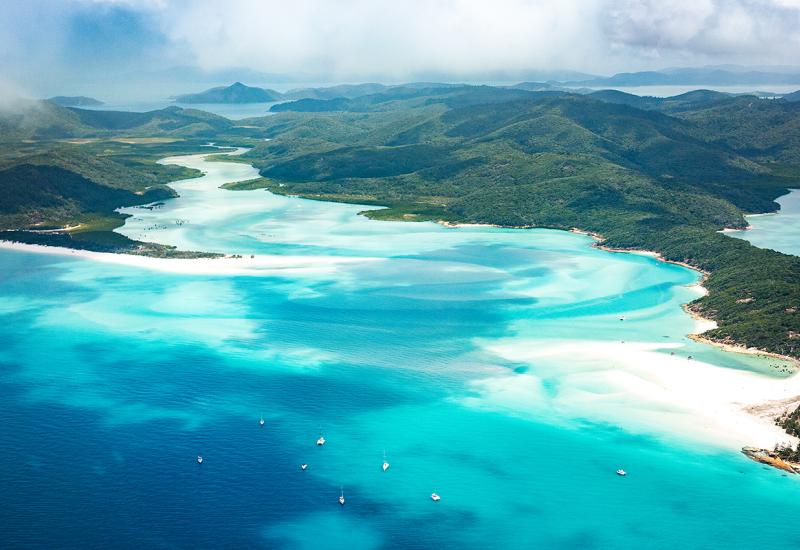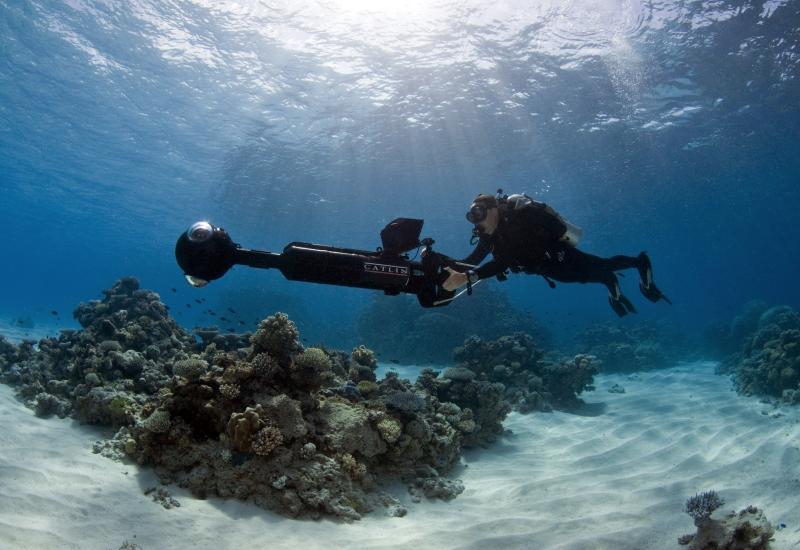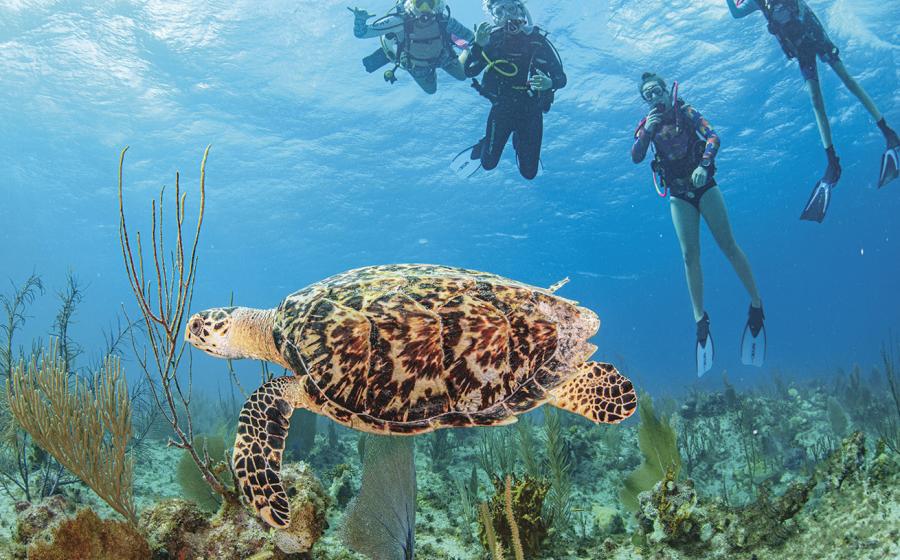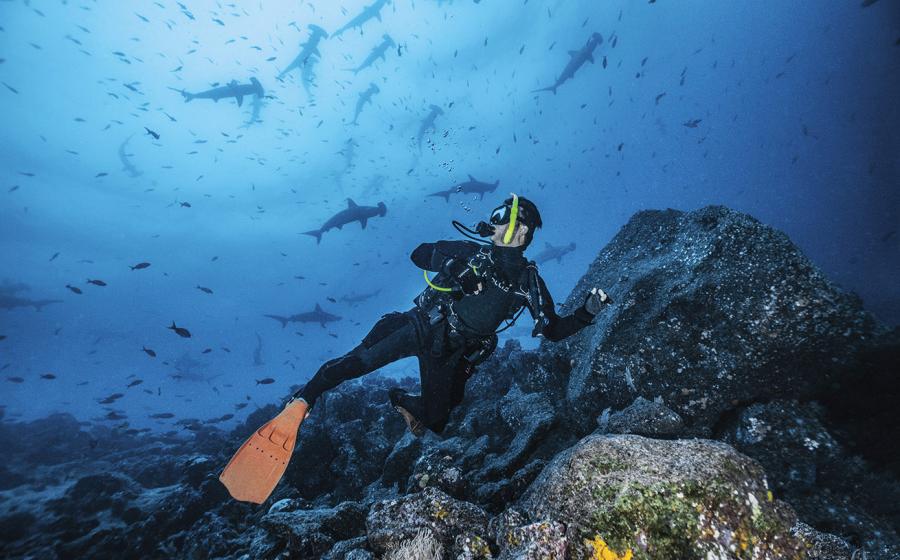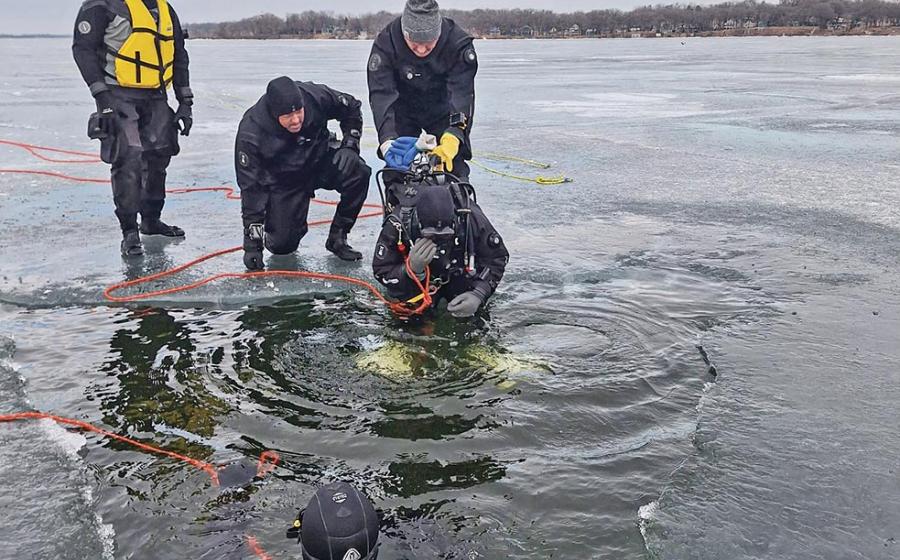Tahiti: A Shark Diving Sensation
Tahiti is the picture postcard of a South Seas paradise - lush tropical foliage, fragrant flowers, powder white beaches, sparkling blue seas, friendly smiling people, beautiful women, fast-beat Tahitian dance music, delicious fresh fruits and fine foods. It's the vacation fantasy that we all yearn for, except this world is for real.
To a diver, Tahiti spells sharks - tons of sharks that can be observed and enjoyed by both scuba divers and snorkelers alike. With an estimated population of 240,000 residents, Tahiti (more correctly known as French Polynesia) is literally outnumbered by the sharks that inhabit the outer reefs and open seas. While no one knows the exact number, the shark population is estimated in the millions. And because of the extraordinary underwater visibility (often 200 feet), it is not uncommon for a diver to view more than one hundred sharks on a single dive.

According to shark expert Dick Johnson, in his book Sharks of Polynesia, at least 16 shark species have been recorded in French Polynesian waters. It is definitely a sharky place, as I have observed five species in a single day of diving: Gray Reef sharks, Silvertips, Great Hammerheads, Whitetip Reef sharks and small Blacktips. Few places on earth offer this kind of variety and abundance for shark dives. We flew from Los Angeles to Papeete in approximately 7-1/2 hours non-stop. Since French Polynesia is south of the equator, but with only a two-hour difference in time zones, jet lag is hardly noticeable.
After an overnight in Tahiti, we departed early the next morning for Rangiroa Atoll, 217 miles (350 km) northeast of Papeete. Sparsely populated and seldom visited by most tourists, this region is made up of 78 islands & atolls, part of a chain known as the Tuamotu Archipelago.
Rangiroa sort of an elliptical-shaped atoll encircled by a coral barrier reef, dotted with small islets. It is the largest Polynesian atoll, with a lagoon measuring 42 miles (67 km) long by 16 miles (26 km) wide. You can dive on the inside of the atoll (the lagoon), the outside of the atoll (the drop-off) or in one of the many passes (channels) that allow the sea to flow in and out of the lagoon during tidal changes. Because of the enormous amount of seawater contained in the lagoon, currents in the passes can sometimes reach seven knots - quite a ride for a drift diver.
On the first day of diving, our French dive guide Ives Lefevre chose Tiputa Pass, a deep water channel just a few minutes boat ride from the hotel dock. Some call it the Pacific's undersea capital of shark diving.

We rolled off the boat and descended into a blue void of incredibly clear water. Visibility must have been 200 feet or better. It was an absolutely stunning panoramic view. I could see a number sharks below me. But wait a minute; I could also see sharks to the left, to the right, in front of me and behind me. Some were solitary cruisers while others swam in small packs.
They were all over the place, like snowflakes in a blizzard.
Our guide led us to a small coral cave tucked away in the side of the pass at 110 feet. Once inside, I surveyed the most remarkable vision imaginable. It was an eye popper! Cruising just outside the cave was a parade of more than 150 sharks (I stopped counting after 100). As far as the eye could see, there were sharks lined up in formation, slowly swimming to and fro. They were waiting for the feed.
Ives uncapped his bucket of chopped fish and the scene turned electric. Now the sharks were darting in erratic flight, often bumping into each other as they competed for the food. At one point, the guide lost his bucket and it rolled down a coral slope. At that point, the feed turned into a frenzy, as sharks rolled and wrestled for the food. It was over in a minute, but that minute seemed like hours. I could feel the adrenaline rushing through my veins.

On another day, we motored a mile outside Tiputa Pass to make what our guides described as the Pelagic Dive. This meant diving in the open ocean with the bottom 600 feet below. Oh boy, not the most comfortable feeling - but certainly a different adventure. As we descended to 50 feet, I could see eight Silvertip sharks rising straight from the deep like Polaris missiles. There is nothing quite as exhilarating as staring directly into the business end of a hungry shark.
The Silvertips swarm calmly around us, like Indians circling a wagon train in an old movie. Instinctively, we divers formed a tight cluster with our tanks back to back. Every so often, one of the Silvertips would make a run toward us, often bumping our fins or being deflected by the guide's defense stick. It was both exhilarating and terrifying.
On the third day, we made a deep dive at the outer edge of the same pass. Our guides had told us about a pair of Great Hammerhead sharks, often seen on a deep coral plateau eating eagle rays. While we did not observe the feeding, we did spot the big Hammerheads (I mean BIG). Although we were some distance away, I would judge these creatures to be 16 to 18 feet long. During decompression, we drifted through the pass on the incoming tide, stopping at small coral caves to observe Whitetip Reef sharks snoozing in the dark recesses. During the drift we counted hundreds of slowly patrolling Gray Reef sharks.

On subsequent days our shark diving was punctuated by encounters with giant manta ray, huge Napoleon wrasse, and very large moray eels. We explored small coral caves occupied by snoozing Reef Whitetip sharks. At other locations we encountered schools of bright red soldierfish, yellow & white Moorish Idols, and other exotic species. Every dive was a new adventure... a continuous stream for delightful discoveries.
This but a small sample of Tahiti thrills that await visiting American divers. The variety of diving adventures is virtually endless. There are eleven different islands and more than twenty-two dive centers offering regularly scheduled shark encounters.
Two things are for certain. Tahiti definitely has more sharks than people, and if you ever visit this South Seas paradise, you will want to return for more. This place is packed with both undersea beauty and breathtaking thrills.
RAI MANTA CLUB Avatoru, Rangiroa, French Polynesia Tel: (689) 96 84 80 Fax: (689) 96 85 60 E-mail: [email protected] Manager: Ives Lefevre
BLUE DOLPHINS DIVING CENTER Hotel Kia Ora Rangiroa, Rangiroa, French Polynesia Tel. (689) 96. 03. 01 / 96. 03. 84 poste 392 Fax. (689) 96. 03. 01 E-mail : [email protected] Managers: Junko Kida & Pascal Jogut
RANGIROA PARADIVE Pointe Ohutu c/o Pension Chez Glorine, Rangiroa, French Polynesia Tel. (689) 96. 05. 55 / 96 . 02. 69 Fax. (689) 96. 05. 50 E-mail : [email protected] WEB: www.chez.com/paradive Manager: Bernard Blanc
THE SIX PASSENGERS Baie d'Ohutu, Rangiroa, French Polynesia Tel. (689) 96. 02. 60 / 96. 03. 05 Fax. (689) 96. 02. 60 E-mail: [email protected] WEB: www.the6passengers.com Manager: Nanou Chapuisat
Name: Tahiti is the generic name, but correct name is French Polynesia
Geographic Location: Situated halfway between the United States (4,000 miles) and Australia (3,800 miles).
Size: Aproximately 118 islands in five island groups, spread across 4-million square miles of the South Pacific.
International Airport: Faa'a International Airport, Papeete, Tahiti
Flying Time: About 7-1/2 hours non-stop from Los Angels to Papeete
Time Zone: 2 hours later than Los Angeles: 5 pm in L.A. is 3 pm in Tahiti.
Entry Requirements: U.S. citizens only require a valid passport and a return airline ticket.
Languages Spoken: French and Tahitian are the two official languages. English, Spanish and Italian spoken at most hotels and dive centers.
Money: The Pacific Franc (CPF) is the official currency, but U.S. dollars and credit cards are accepted at most hotels and dive centers.
Exchange Rate: U.S. $ 1 equals 95 CPF francs
Tipping: Tipping is not part of the Polynesian culture.
Electricity: 110 or 240 volts AC at 60 cycles - U.S. appliances require converter plugs.
General Climate: Tropical to sub-tropical; sunny with gentle trade winds. Air temperature ranges from 72 F to 90 F degrees. Suitable for tee shirts, shorts & sandals.
Terrain: Mixture of high volcanic islands groups and low lying flat coral atoll islands.
Islands For Diving: Tahiti, Moorea, Bora Bora, Huahine, Raiatea, Tahaa, Rangiroa, Tikehau, Fakarava, Manihi and Rurutu.
Tourist Board: Tahiti Tourisme 300 Continental Blvd., Suite 160 El Segundo,CA 90245 Website: http://www.GoToTahiti.com EMail: [email protected] Toll Free: 800-365-4949 Fax: 310-414-8490 Dive Operators Association:
GIE PLONGEE de TAHITI & ses iles PO Box 6014 98702 Faa'a, Tahiti Website: http://http://www.diving-tahiti.com/ EMail: [email protected] Tel: +689 53 34 96 Fax: +689 43 10 65



